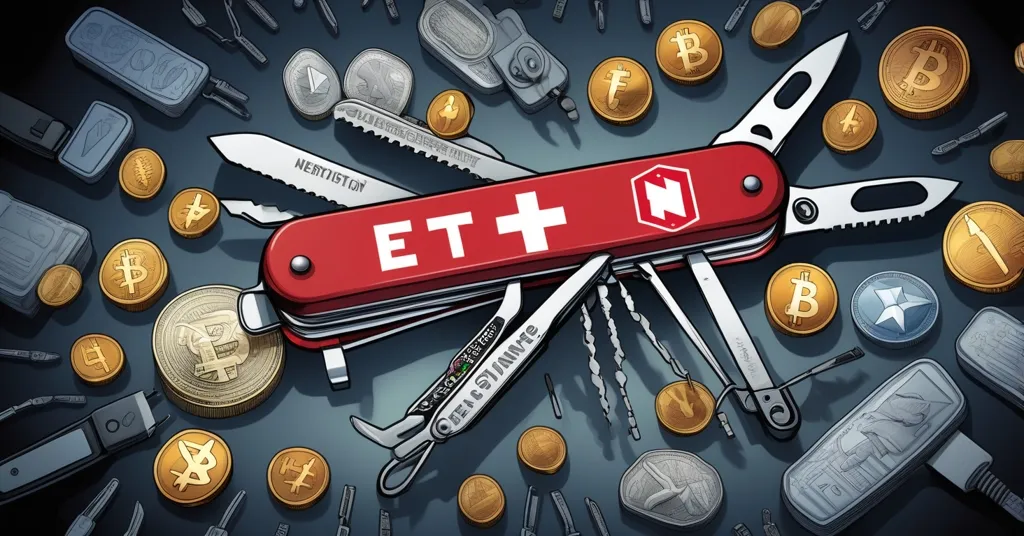Exchange-Traded Notes Surge in Crypto: A Sophisticated Alternative to ETFs

Crypto’s Second Act: The Quiet Rise of Exchange-Traded Notes
Exchange-Traded Notes (ETNs) are emerging as a sophisticated alternative to traditional Exchange-Traded Funds (ETFs) in the cryptocurrency space, offering investors more than just price speculation.
- ETNs provide structured exposure to multiple crypto assets.
- Europe’s regulatory environment supports ETNs.
- U.S. regulatory caution limits ETN availability.
- ETNs may become the default for serious crypto allocation.
Spot Bitcoin ETFs were once hailed as the gateway for mainstream finance into the world of cryptocurrencies. “ETFs gave institutions a straightforward method of gaining exposure to Bitcoin and Ethereum without grappling with private keys and custody complications,” says Bundeep Singh Rangar, CEO of Fineqia, a digital asset business. However, ETFs have a significant limitation: they’re stuck tracking only the price of the underlying asset. As Rangar puts it, “In capital markets, an investment that cannot generate returns beyond price appreciation has an inherent flaw.” This means that when the market moves sideways, ETFs can stall, leaving investors without the additional returns they seek.
Enter ETNs, which are quietly gaining traction, especially in Europe. Unlike ETFs, ETNs don’t just follow the price; they offer exposure to a variety of crypto assets, including staking rewards and DeFi portfolios. Think of ETNs as the Swiss Army knife of crypto investments – versatile and equipped to handle the demands of investors looking for ways to earn more than just price changes. Europe’s regulatory framework, particularly the Markets in Crypto-Assets Regulation (MiCA), plays a crucial role in this rise. “MiCA provides a unified legal framework for crypto assets across EU member states, mandating clearer standards for the issuance, operation, and marketing of digital assets,” Rangar explains. This framework helps address credit risk and supports the growth of ETNs by offering a more secure and regulated environment.
In stark contrast, the U.S. regulatory environment poses a challenge. The Securities and Exchange Commission (SEC) takes a cautious approach, limiting the availability of versatile crypto investment products like ETNs. “The SEC’s cautious approach has limited the availability of more versatile crypto investment products like ETNs,” Rangar notes. This regulatory disparity is a significant hurdle for U.S. investors looking to explore the full range of crypto market opportunities.
The shift towards ETNs isn’t just a trend; it’s a potential paradigm shift in how serious investors approach crypto allocation. As institutional investors demand diversification and yield, ETNs are poised to meet these needs. “ETNs, though not without pitfalls, appear to strike a better balance between these demands,” Rangar asserts. This suggests that ETNs could soon eclipse ETFs as the go-to investment vehicle in the crypto space.
However, while ETNs offer exciting possibilities, they come with their own set of challenges. They are complex instruments, and as Investopedia advises, investors should only invest if they fully understand them. Additionally, ETNs might benefit from favorable tax treatment, but they’re not immune to market risks or tracking errors. It’s essential for investors to weigh these factors carefully.
Despite these challenges, ETNs represent a sophisticated evolution in crypto investment, catering to the nuanced needs of a maturing market. Whether they’ll truly overshadow ETFs remains to be seen, but the crypto investment game is undeniably changing, and ETNs are at the heart of this transformation.
While ETNs offer new opportunities, it’s important to remember that Bitcoin remains the cornerstone of the crypto market. As a Bitcoin maximalist might argue, while diversification and yield are important, the fundamental value and stability of Bitcoin should not be overlooked. ETNs can fill niches that Bitcoin alone might not serve, but they should complement, not replace, the king of cryptocurrencies.
Key Takeaways and Questions
- What are the limitations of Bitcoin ETFs?
Bitcoin ETFs are limited to tracking price alone, which can stall returns when the market moves sideways, and they do not offer exposure to other aspects of crypto like staking rewards or DeFi portfolios.
- How do Exchange-Traded Notes (ETNs) differ from ETFs?
ETNs offer structured exposure to multiple crypto assets, including staking-based tokens, DeFi portfolios, and multi-asset investment baskets, providing more than just price speculation.
- What role does the Markets in Crypto-Assets Regulation (MiCA) play in the rise of ETNs?
MiCA provides a unified legal framework for crypto assets in the EU, mandating clearer standards and addressing credit risk, which supports the growth of ETNs.
- Why is the U.S. regulatory environment a disadvantage for crypto investors?
The SEC’s cautious approach limits the availability of versatile crypto investment products like ETNs, restricting U.S. investors’ ability to capitalize on crypto market opportunities.
- What are the potential future implications for ETFs and ETNs in the crypto market?
ETNs could eclipse ETFs as the default instrument for serious crypto allocation, especially as institutional investors seek diversification and yield, and if regulatory environments continue to support their growth.



